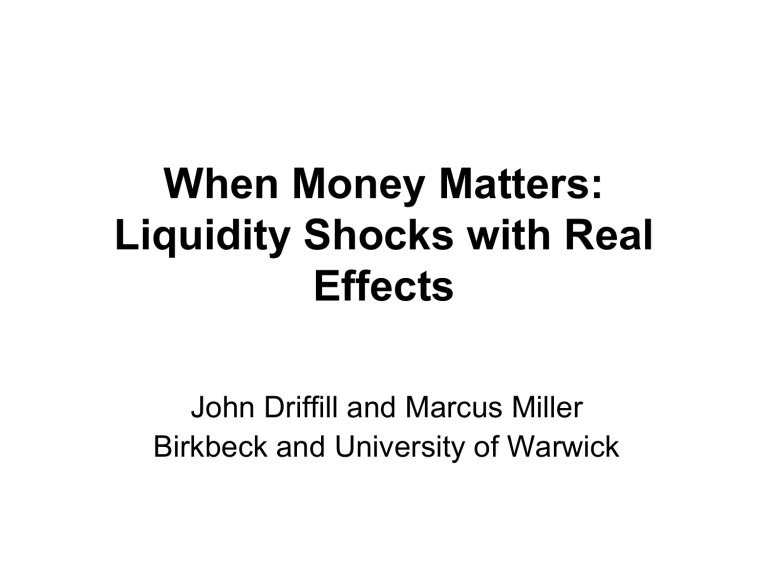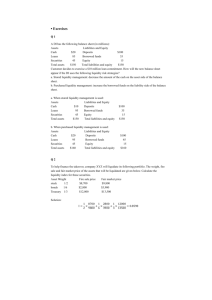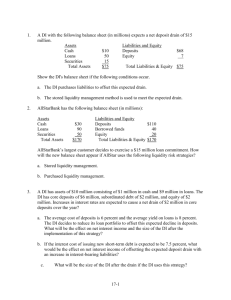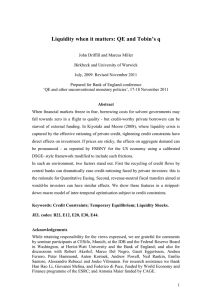When Money Matters - World Economy & Finance Research

When Money Matters:
Liquidity Shocks with Real
Effects
John Driffill and Marcus Miller
Birkbeck and University of Warwick
Summary
• Kiyotaki and Moore (2008) show how an unexpected temporary tightening of credit cuts current investment and future supply.
• FLEXPRICE: With flexible prices and wages, aggregate demand matches current supply via a ‘Pigou effect’ and there’s no unemployment.
• FIXPRICE :If prices and wages are inflexible downward, demand failures and unemployment emerge
• But, given the capital depletion in the recession, deficient demand turns to excess demand as recovery progresses, i.e. there is a risk of ‘stagflation’ .
Great Moderation has succumbed to credit crunch
• US unemployment rate has doubled from 4.8 per cent to
9.5 percent and may peak at 10.5-11
• “the world is currently undergoing an economic shock every bit as big as the Great Depression shock of 1929-
302” , Eichengreen and O’Rourke (2009).
• “The good news is that the policy response is very different.”
• The bad news is that this owes virtually nothing to modern macro paradigm.
Kiyotaki and Moore (2008) Liquidity,
Business Cycles, and Monetary Policy
• firms face credit constraints - with real consequences for composition of output.
• credit market imperfections lead to a precautionary demand for money.
Adding Non Market Clearing to KM
• With money wages and prices fixed, goods and labour markets may fail to clear
(as in fix-price macroeconomics)
• cf. Akerlof and Shiller.
• Del Negro et al. at NY Fed have similar idea, using Calvo contracts
We turn to temporary equilibrium:
French ‘fix-price macro’ Benassy*/Malinvaud
• Note that if prices are inflexible downward, there will be no Pigou effect to stabilise aggregate demand in the face of a fall of investment
• A fall in demand will contract employment if the real wage is determined by bargaining, as argued for the UK in Layard and Nickell, Alan Manning.
• Graphical representation follows
*Was Ph D student of Debreu at Berkeley
Short run determination of net output
Aggregate
Demand
E
D(X;q;K;
) wage bill
( w*L )
Bargaining
Wage w* real wage rate
π+θ
D
45° X
X f
Net Output ( X = rK )
X
D*
Marginal
Product of
Labour
Net Output (X
E*
=rK )
L L
The model in summary:
Liquidity constraints
• Kiyotaki and Moore (2008) ‘Liquidity, Business Cycles, and Monetary Policy’
• Money and equity
• Money is completely liquid
• Equity is not so liquid
– only a fraction of holdings can be sold each period
– only a fraction of newly produced capital goods can be financed by issuing new equity
Investment
Entrepreneurs can only finance investment using money, selling existing equity claims to others, raising equity on new capital, and spending out of current income
Workers: trapped in time
• Spend what they get
• Rational and forward-looking, but impatient and credit constrained.
• No borrowing
• They can hold money and equity if they choose
• But they choose not to save
• Consumption equals wages
Heterogeneous entrepreneurs
• May (prob π ) or may not (prob 1π ) have an idea for a profitable investment
• Those with no ideas (no investment)
– Consume
– Save in form of money and equity holdings
• Those with an idea (Investors)
– Buy new capital goods
– Issue equity against them, i.e. borrow
– Use money, other equity holdings, and current income to finance investment
Liquidity constraints
• Entrepreneurs can raise equity against up to a fraction
θ of new investment.
• They can sell of a fraction φ t
(theirs and others) n t of pre-existing equity
• But money is perfectly liquid n t
1
) i t
t
) n t m t
1
0
Entrepreneur’s budget constraint
• Budget: c t
i
( t t
1
t
n t
)
( t t
1
m t
)
r n t t
• p – price of money; q – equity price
• λ – 1-depreciation rate
• n equity held by entrepreneur
• Objective - max exp U:
E t
c s
Production
• CRS / C-D production function, capital and labour y t
1
A k l t t t
• KM: wage clears labour market
• DM: fix money wage and price level – entrepreneurs keep the surplus y t
w l t t
r k t t
.
Aggregate Demand (IS curve)
Investment demand
(1
q I t t
r t
t t
1
t
t
p M t t
R q K t t
Aggregate demand (‘IS curve’)
( ) t t
I t
r x t
t
1
t
q t
R q t
K t
p M t t
q t
R
1
1
q t
Portfolio Balance (LM)
(1
) E t
r t r t
1
1
q q t t
1
1
/
N q s t t
1
p t
1
/
1 p t
E t
p t
1
/ p t
r t
1
r t
1
t
1 q t
1
t
1 q t
1
t 1 t
1 t
1
R q N s t
1 q t
1
R
1
/ q t
N t
1 s
I t
t
K t
(1
K t
Relaxation of credit contraints in a fully employed economy q
E
B
U
E'
U'
U
K*
U'
K**
K
Big bang with anticipated repeat q
E
B
A
C
I
U'
E'
N
K*
U'
K**
A
K
Path: EBICE’
Dynamics of adjustment of q and K with spare capacity and constant prices and wages q
Equity
Price
S
Asset price stationary
Δq/Δt = 0
Z
Δ Q
C
U
C
K
E
Z Δ K
Zero net investment
ΔK/Δt = 0
U
K*
S
Capital Stock
K
Temp liquidity shock : stock market falls, K depleted
– followed by recovery as liquidity is restored q
Equity
Price Liquidity
Shock
LS
S'S'
V
E
E'
U'U'
K
' K*
R SS
Capital Stock
K
Policy: QE in Credit crunch
• With firms who want to invest more credit constrained and workers income constrained - no Pigou effect to stimulate entrepreneurial consumption, a ‘credit crunch’ causes recession.
• The antidote discussed by KM should work here :
Quantitative Easing as the government supplies liquidity in exchange for corporate securities (not government bonds) .
• i.e. more like Fed policy than Bank of England
Adding (more) behavioural aspects
• Phase diagram can portray effects of an asset price bubble as discussed in
Akerlof and Shiller’s book Animal Spirits
[Perhaps Paul De Grauwe’s approach to
‘animal spirits’ be incorporated by making
state contingent , so there’s less innovation in recession?]
Supply bottleneck and bootstrap effects.
c U''U''
S'S'
SS
U'U'
N
S''S''
S'S'
SS
E
U''U''
E'
F
F'
L
U'U'
K*
E
R
R'
S''S''
K
So far so
Keynesian, but beware: risk of a
‘supply bottleneck’ after a recession
Aggregate
Demand
E
D(X;q;K;
)
π+θ
D
45° X
X f
Net Output ( X = rK )
D*
I
X
E*
L Net Output (X =rK )
Switch from spare capacity to excess demand in recovery: risk of ‘stagflation’?
Liquidity
Shock q
LS q
S'S'
S'S'
Excess
Demand
E'
V
B
Excess
Demand E
B
V
R
Deficient
Demand
SS
K
'
E'
K*
Liquidity
Shock
LS
E
Capital Stock
K
Need to switch regime, like
Neary Stiglitz
(1983)?
R
Spare
Capacity
SS
K
' K*
Capital Stock
K
KM framework introduces Keynesian elements into DSGE
• In Kiyotaki and Moore (2008) model, tightening credit constraints cut current investment and future aggregate supply.
• If prices are inflexible, downward Keynesian demand failure can emerge after a liquidity shock
• There is a risk of ‘stagflation’ as demand recovers faster than supplyso it’s back to flexprice growth modelling
Conclusion
• Modelling (severe) financial frictions creates role for money as the liquid asset
• Agents heterogeneous – get away from
‘representative household assumption’
• Credit crunch has real effects
• Route out of recession may encounter supply bottlenecks
• Simple schematic model
Impulse responses to negative liquidity shock
Impulse responses to negative liquidity shock
‘Calibration’
• φ = 0.2 (fraction of existing assets an entrepreneur can sell);
• discount factor β = 0.96;
• fraction of new capital against which an entrepreneur can raise equity, θ = 0.4;
• probability of an entrepreneur having an idea for an investment, π = 0.2;
• the annual survival rate of the capital stock λ = 0.8.
• M = 50; price of money p = 1.
• ρ =0.6 (survival rate of shock to φ)
• Steady state: q = 1.12; r = 0.252; K = 296; Mp/K = 0.169.







